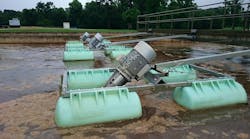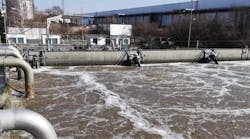Editor’s note: This is Part two of Water Technology’s February feature titled, “The factors that impact Venturi meter accuracy.” In Part one, the author discussed how the materials used and the time in service can impact a meter’s accuracy. If you missed Part one, please visit WaterTechOnline.com to read the entire article. For Part two of this article, factors such as minimum to maximum flow rate effects on discharge coefficient usage, secondary instrumentation limitations, undocumented flow pattern effects and more will be discussed.
Depending on manufacturer’s claims, the classical design of a Venturi meter maintained a constant discharge coefficient down to a pipe Reynolds number (Rd) of approximately 200,000. This simply means that as long as the minimum flow rate Rd is maintained above this value, the discharge coefficient of the classical design (which is 0.984, in most cases) remains constant. If, however, the flow rate drops below a pipe Rd level of 200,000, there is a bias error that must be applied to the discharge coefficient, which will progressively lower its value.
For example, if the minimum flow rate Rd value is 80,000, the 0.984 coefficient cannot be used if the stated accuracy of +/-1.0 percent is to be considered valid. Stated another way, if the minimum flow rate pipe Rd is 80,000, the accuracy of the meter at that rate would be +/-2.0 percent and it would improve to +/-1.0 percent as the flow rate increased to the level where the pipe Rd was 200,000.
For a “quick” determination for pipe Rd, use the following formula: GPM x 2790/line size in inches or MGD x 1.935/line size in inches.
This will calculate to within +/-10 percent of the actual pipe Rd for liquid applications.
Secondary instrumentation limitations
The typical secondary instrument system consists of a differential pressure transmitter connected to the Venturi meter through impulse lines. The following are important points concerning the secondary instrument system orientation and installation:
- Air in the impulse lines or at the differential pressure transmitter location can cause errors that are difficult to estimate, but do exist. The impulse lines should be oriented so air is kept in the pipeline and not in the impulse lines. A number of solutions exist that respond to this requirement.
- Impulse lines should be as short as possible/reasonable and both the high- and low-pressure legs should be bundled together so there is no temperature inversion between them.
- In general, the most accurate performance range (minimum to maximum flow rate range) for a single digital type differential pressure transmitter is 8:1 on flow.
- For flow rate ranges beyond 8:1, a dual differential pressure transmitter system is recommended where the low-range transmitter is utilized for process flow until its accuracy exceeds allowable limits; then a high-range differential pressure transmitter covers the balance of the full range. With two differential pressure transmitters, 64:1 flow rate range is possible (assuming the minimum flow rate differential is processable); with three differential pressure transmitters, a range in excess of 700:1 is possible.
- For digital differential pressure transmitters, while there are varying opinions concerning what the minimum input differential has to be, research indicates that if there is not a lot of loop noise, the smart digital type differential pressure transmitter can process an input differential of as low as 0.10 inches. However, if one is designing a metering loop, a minimum input signal of 0.25 inches is a safer level to operate at. Note that if you are using diaphragm seals, the minimum signal should be 1.0 inch or greater due to the deflection sensitivity of the seal material.
Undocumented flow pattern effects
One of the things noted over 25 years of inspecting older installations is that, at the time of their installation, a proper accounting of the approach piping effect on the Venturi meter performance was not done. Meters were installed and standard accuracies were assumed even though the piping did not support those accuracy statements. A very good database of calibrated meters has been maintained, allowing the approach piping for these older installations to be reviewed and assigned an educated value that will account for a nonstandard installation condition.
Modified short-form Venturi meter performance
As discussed in Part one, the first modified short-form Venturi meter was the Universal Venturi Tube. Since the Universal Venturi Tube did not have annular chambers, the points noted above concerning the problems with annular chambers do not apply. Due to the Universal Venturi Tube’s single-tap design, the interface of the piezometer face to the flow must be sharp and free from burrs or debris; otherwise, the differential pressure developed may be in error, and thus, the indicated flow rate will be inaccurate. Unfortunately, many of these devices have bronze material at both the high-pressure tap location, as well as the entire throat section (in most cases). Galvanic corrosion and/or erosion may occur at these locations and, if not corrected, may result in impaired pressure signals and therefore impaired accuracy. Undocumented flow pattern effects may also be a factor, but there is adequate test data available today that can be used to correct any misinformation from the original installation.
The pipe Rd limitations have the same effect on the Universal Venturi Tube except that the minimum pipe Rd for the Universal Venturi Tube is 80,000, which means the flow rate can be quite a bit lower than the classical, yet still maintain the standard +/-0.5 percent accuracy that is the standard accuracy for the Universal Venturi Tube. However, if the minimum flow rate was at a pipe Rd of 40,000, the accuracy of the Universal Venturi Tube at 40,000 pipe Rd would be +/-1.5 percent improving to +/-0.5 percent as the Rd value reached 80,000.
What is the normal change in accuracy?
Experience has shown the discharge coefficient of the Venturi meter generally drops with a change in the internal surface condition of the meter and/or any change to the cross-sectional tolerance of the meter from its original “as built” geometry. In addition, a change from a sharp edge piezometer to a rounded edge will also result in a drop in the value of the coefficient. Because of its position in the flow formula for Venturi meters, if the coefficient drops due to change in tolerance, tap effect or surface irregularities, the indicated flow rate will be higher than it actually is — this is called “over-registration.” If annular chambers are in use, the pressure produced by the high- and low-pressure rings may or may not be impaired due to internal plugging; depending on what the result is (lower high pressure, lower low pressure or both), the differential produced by the comparison of the high- and low-pressure signals internally to the differential pressure transmitter will be in error and the effect can be either under-registration or over-registration.
Bruce Briggs is the president and principal of Primary Flow Signal Inc., a global manufacturing, engineering and technology resource focusing on highly accurate, repeatable and reliable differential flow meters. In his more than 30 years in the industry, Mr. Briggs has built, arguably, the largest team of expert flow metering, hydraulic and applications engineers, along with technicians and specialists of diverse critical expertise. The companies are comprised of a number of enterprise-owned, fully integrated manufacturing facilities offering a world-class platform for solutions and support for the oil and gas, power, municipal water, wastewater and automotive markets.


